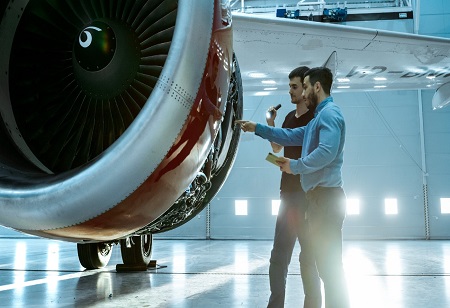
A prime contributor to the development of the Aircraft Industry is Maintenance which is formidable for operating costs, flight delays, and cancellations. Even with longer-lasting aircraft and more durable engines, airlines are evolving by spending ample time and money on maintenance rather than fuel or crew. The requisite for keeping assets available for operations is known; cutting maintenance, repair, and overhaul (MRO) costs is a recognizable issue. Aircraft operators are extending development for dunting troubleshooting and mechanical flying machines inspection for reduction downtime, better-task planning, and optimized parts management. Innovative technologies and techniques have a wide range of OEMs, MROs, and suppliers, which include robots - made of aircraft, drones, virtual/augmented/mixed reality-aids, machine learning/neural networks/artificial intelligence, blockchain, 3D printing, additive manufacturing, and more. The following are a few initiatives in aircraft maintenance for smarter, faster, and cheaper operations.
Inspection Robots And Drones
Currently, typical projection inspections of commercial aircraft utilize up to six hours for Robots and drones that have the potential for this time dramatically and, at the same time, offer top-notch accuracy of checks, freeing up engineering time, reduction of maintenance costs, and improving safety. Miniature, cockroach-inspired camera robots deployed in swarms can be turned without any firm inside an engine to help inspection of difficult-to-access components. Renowned companies such for development of 1-cm-long (0.4-in) versions that can even remove and replace defective material. The company airlines have conducted experiments with an autonomous drone, edifying the developed by MRO Drone, which can inspect a complete narrow-body outline in 30 minutes and a wide-body in one hour. Implementing technology borrowed from nuclear reactor inspection, the RAPID (Remote Automated Plane Inspection and Dissemination) system will be able to inspect specific structures, such as after reports of a bird strike.
Foreign-based company technics are implementing a robot that uses a patented suction mechanism to adhere to and traverse many surfaces, including aluminum, glass, and carbon fiber, even when aircraft surfaces are wet or require an upside-down inspection. Apparatus with high-definition camera and detecting sensor-technology, robot records and that transmits video images to a ground-bind screen for actual analysis by line-maintenance staff, enablement of efficient visual inspections on the tarmac or in the hangar. The robot might be including ultra-sound and thermographic testing. Companies involve businesses from Austria, Germany, and Italy to develop a robotic inspection solution using a cornering inspection device such as 3D-surface inspection, thermography, or X-ray – that will eliminate complications in the programmable robotic motion path. The project is aimed at reduction of the time-consuming and expensive process when programming robots for an application-specific solution.
Hangar of the Future
The aircraft project combines various technologies for digitizing and automating maintenance activities to increase summative maintenance process efficiency. The companies are incorporating the use of innovative technologies and intelligent objects, IoT (Internet of Things) which are connected equipment such as ‘cobots’ (collaborative robots – like the Air-Cobot), drones, scanners, cameras, non-destructive sensors, with aircraft technical documentation and aircraft in-service data collated.
Augmented and Mixed Reality
The Next-Gen of Aviation Professionals entering the aviation industry has been representing a new generation of learners. For engaging and aligning their needs, the aviation community has been harnessing innovative technologies to look beyond traditional training methods and enhance workforce practices. 3D-holographic content into the physical world for training technicians on how to help in the maintenance of aircraft. Students can be engaged to, for example, inside a jet turbofan engine or interact with 3D cockpits. Companies are using intuitive technologies that offer a natural means of interactive sources. There’s device. All you need are simple gestures for creation and altered holograms, where a person’s voice is used to communicate with apps and your eyes to navigate and analyze content. Using smart glasses and augmented reality (AR), people are getting helped to simplify the complex process of wire installation, resulting in a 25 percent reduction in production time and lowered-error rates to zero. The augmented reality system helps to kit 3D drawings based on wire definition plans, which are presented to the end-user, spatially aligned to an aircraft, on a wearable device.
Big Data
The proliferation of sensors on modern aircraft-combined with better data-routers has led to a 60-fold increase in the data parameters collected from each flight head of services business development. Within 2025, above 38000 new aircraft will be in operation worldwide, producing more data than previous generation aircraft. The latest engines will be generating one terabyte of data each cycle. For MROs, this defines an increasing amount of data knowledge and the growing complexity of their businesses. MROs are turning to technologies such as artificial intelligence, big data, machine learning, deep learning, neural networks, blockchain, other developing and information management technologies to better manage this deluge of data.
Conclusion
The MRO industry has been almost excessively dependent on human labor and incurring a decade with industries such as the industry of pharmaceutics and devices utilized in medical sector which might be in adoption and may be undergoing a shakeup.
We use cookies to ensure you get the best experience on our website. Read more...